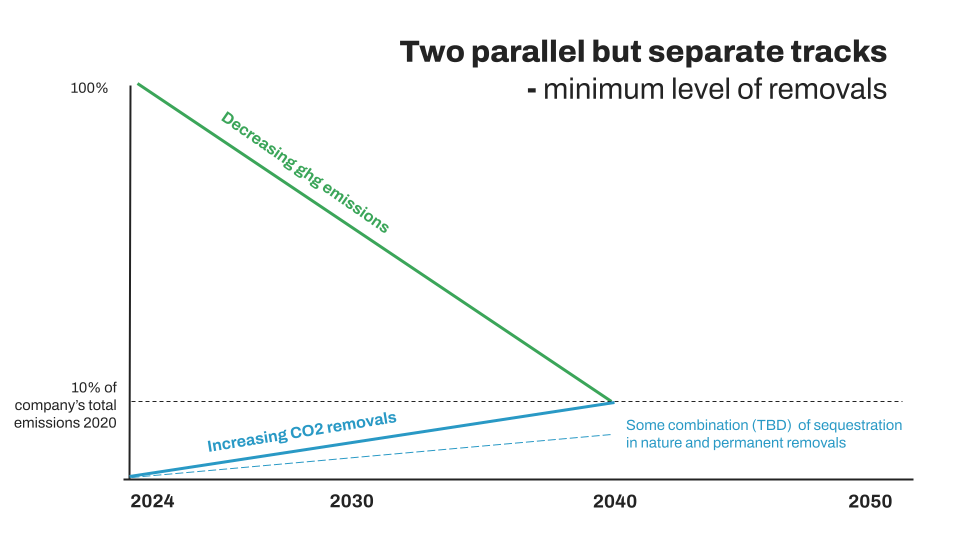Carbon dioxide removal is required to limit global warming to 1.5°C. Scenarios in which warming is limited to 1.5°C assume large volumes of future deployment of carbon removals. But scientists say there’s a carbon removals gap and in order to achieve the needed scale, removals have to accelerate rapidly. That’s why Exponential Roadmap Initiative has started work aimed at incentivising companies to finance removals in addition to reducing emissions – and eventually get rewarded for it through a global standard. Claire Wigg, Head of Climate Performance Practice, explains.
Question: Why is it important to accelerate carbon removals?
Answer: It’s important to accelerate carbon removals because carbon removals are an inherent part of scenarios that will keep global temperatures in the safe space for humanity, the 1.5°C scenarios. But in the real world, removals are not where we would need them to be to follow the 1.5°C pathways.
What’s more: Carbon removals mean new technology, new infrastructure, new investment. If we don’t start now with developing this technology, building that new infrastructure and making these new investments, we won’t be able to do the removals at scale later on.
What are carbon removals?
Carbon dioxide removals refer to technologies, practices or approaches that remove and durably store carbon dioxide from the atmosphere. Methods differ – they include eg afforestation, reforestation and improved forest management but also direct air carbon capture and storage.
For more detail, see this factsheet from the Intergovernmental Panel on Climate Change.
Q: What role can companies play with regard to carbon removal?
A: At the moment companies are communicating about their net zero goals in terms of emissions, with the implicit assumption that they will contribute to the removals when they reach net zero, in 20-25 years’ time. But, actually, that doesn’t fit with the 1.5°C scenarios because the 1.5 scenarios tell us that carbon removals have to be happening now. And we know that, in practical terms, we can’t conjure up removals at large-scale, from nothing, in 20-25 years’ time. But, this hasn’t been on the radar.
And that’s completely understandable because the priority needs to be to reduce emissions. We have collectively incentivized companies to set targets, to reduce emissions and to show the action they’re taking.

Q. How are the standards that are relevant to companies currently treating carbon removals?
A: The Science-based Targets Initiative (SBTi) approves companies’ emission reduction targets, to reach a so-called residual level at some future date and reaching this “net zero” state involves doing removals from that point onwards. But they’re not requiring or expecting companies to do be doing removals today, the idea being that the removals will be an option when they’re needed
But it’s wishful thinking to assume those volumes of removals will be available for companies unless the technologies, projects and infrastructure ramp up from now. And, also, it ignores the fact that the scientists tell us we need to be doing removals now and in a gradually increasing volumes every year.
Q: How could standard setters incentivise removals?
A: At the moment, the voluntary climate standards are primarily for greenhouse gas emissions reductions targets. Recognised standards incentivize companies to set targets and to take action because stakeholders and investors want to see whether companies are progressing against these standards. But the entire dimension of setting targets and getting started with carbon removals is currently missing from standard setting, not to mention the fact that the standards are all voluntary.
When it comes to regulations, some industries and geographies are covered by various types of carbon taxes or emissions trading schemes. But again, the focus has been on incentivising emissions reductions rather than carbon removals.
Q: Exponential Roadmap Initiative wants to advance acceleration of carbon removals via corporate action. How?
A: Our proposal is that every company should set off from today on a removals track.
Just as a company has an emissions reductions track that should show a down curve, it should have a separate track for removals, running in parallel but showing an upcurve. When the company reaches net zero, these two tracks would meet up.
We are working with partners including Rethinking Removals and Oxford Net Zero to develop and socialise a proposal on this, in consultation with large corporates, standards bodies and other stakeholders. Our aim is to develop a robust proposal that would get embedded in one or more significant and recognised standards and put a requirement on companies to do removals. Because only then can the idea scale.
The interview was conducted by Andrea Lindblom, Head of Communications.
More resources:
- Climate reporting standards are insufficient: New paper by Oxford Net Zero, Exponential Roadmap Initiative (news post)

